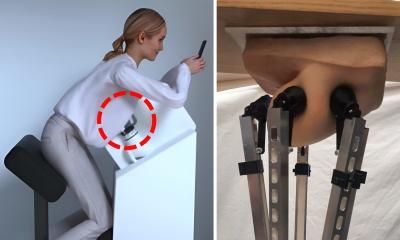Cancer has a smell and breathprint
Research: Scientists have developed the NA-NOSE cancer breath-test
Israel - Researchers are using breath-test technology to detect volatile organic compounds to tell whether a patient has stomach cancer.

Although still in early development, and yet to be clinically tested on a wider scale with bigger studies, the test is showing early potential as a new cancer screening tool.
The breath-test technology relies on the idea that the biology of tumours can lead to the production of specific ‘volatile organic compounds’ (VOCs) – chemical combinations unlikely to be displayed in healthy person’s breath.
Based on his successes in separate studies on lung and head and neck cancers, as well as kidney, Parkinson’s and Alzheimer’s diseases, Professor Hossam Haick from the Israel Institute of Technology – Technion ¬– recently led the team that created a breath test designed to detect stomach cancer. ‘The exact composition of the volatile molecules in the breath is different from person to person and contains a lot of information about the individual,’ he explained. ‘For example, there are differences between men and women, between people that exercise and those that don’t, and between young and old people.
All cells, he added, whether healthy or cancerous, constantly emit such VOCs into the blood, and different cells emit different types and/or amounts of VOCs. ‘Therefore cancer not only has a smell but, at least, different cancers have different breathprints.’
To detect those cancerous breathprints, the Technion team has developed NA-NOSE, an artificial electronic nose that mimics the canine sense of smell. ‘In our electronic nose, the receptors are mimicked by an array of highly sensitive gas sensors,’ Prof. Haick explained. ‘Like the biological receptors in the mammalian nose, these sensors can each absorb a wide variety of gas or vapour molecules.
‘The collective sensing signals are processed by a computer, using a pattern recognition algorithm. But we have to “teach” the electronic nose how to identify a particular smell by controlled exposures in the laboratory.’
The Technion NA-NOSE has high levels of accuracy, he added, with the device achieving ‘excellent’ discrimination between gastric cancer and benign gastric conditions (89% sensitivity; 90% specificity); and early stage gastric cancer and late stage among gastric cancer patients (89% sensitivity; 94% specificity).
The professor believes the Gastric Cancer breath test could be developed to ‘precede and complement’ conventional upper digestive endoscopy with biopsy, as a low-price, high-scale, screening tool to identify individuals who should be referred for an endoscopic examination. ‘The NA-NOSE approach is totally different from conventional cancer diagnostics,’ Professor Haick confirmed. ‘It diagnoses cancer based on a change of the blood chemistry and metabolic activity, which is reflected in the chemical composition of the exhaled breath and not on the basis of tumour imaging, thus permitting earliest cancer detection before a tumour of detectable size has formed.’
Following the present study using a relatively small test population of 130, a larger multi-centre clinical trial with increased sample size is being staged to further develop the technique and confirm its potential. However, he is convinced: ‘This has the potential to reduce cancer mortality by enabling widespread, trustworthy screening, especially suitable for high-risk populations. The ultimate goal of the NA-NOSE project is to identify cancer volatile biomarkers at the earliest stage possible, ideally at the level of a single cell.’
The technique can be used beyond specialist settings and also for immediate diagnosis of fresh cancer tissues in operating theatres, where a dichotomous diagnosis is crucial to guide surgeons.
Identifying higher cancer risk
United Kingdom - A countrywide major study aims to develop a way to predict which individuals have a higher cancer risk, and also to help improve the referral process patients go through before diagnosis.
Researchers will collect and analyse clinical data and blood samples from 20,000 patients with symptoms that could indicate lung or colon cancer, to try to determine which signs and symptoms are most predictive among those who go on to be diagnosed with the disease.
Co-ordinated and led by the University of Southampton, the study will use patient samples from the eight centres within National Institute for Health Research (NIHR) School for Primary Care Research (NIHR SPCR).
The CANcer DIagnosis Decision rules (CANDID) study will also see genetic testing carried out after the recruitment phase, to establish how much extra information genetics provides over and above clinical information.
Under current NHS targets, family doctors must refer urgent cases within two weeks and within 62 days for other cases. However, there is evidence within the NHS that some patients wait much longer and visit their GPs more than once before being referred.
University of Southampton Professor of Primary Care Research, Paul Little said that while clinicians have a ‘reasonable idea’ of predictive symptoms from retrospective and smaller studies, until now there have not been any large prospective studies looking at how predictive particular symptoms are for developing cancer. ‘We need to improve both the early referral rates for cancer but, at the same time, we don’t want to overload the system with lots of people who are at a low risk of having cancer and may have negative side-effects of being over-investigated… Our research aims to aid the patient pathway and help medical professionals, so every patient is dealt with in the most appropriate way and in a timely fashion.’
Results from the £2 million study - funded by the NIHR SPCR - will be available in five years’ time and could not only identify high-risk cancer patients but also mean lower risk patients are not over-investigated.
Hospitals and health systems will also benefit from better targeting of referrals reducing unnecessary use of resources.
The genetic causes of cancers
UK researchers have also identified multiple genetic variations that raise the risk of breast, prostate or ovarian cancer in a development that could lead to new treatments and more targeted screening of the conditions
In the largest study of its kind, more than 80 regions of the genome that can increase an individual’s risk of breast, prostate or ovarian cancer have been found through international collaborative research. Funded by the European Union, Cancer Research UK and the US National Institutes for Health, the research involved scientists looking for genetic variations called single nucleotide polymorphisms (SNPs), which are linked to an increased cancer risk.
They studied the DNA make-up of more than 100,000 people with cancer and 100,000 people from the general population and found alterations that were more common in people with prostate, breast or ovarian cancers.
While each alteration raises cancer risk by a small amount, the 1% of people who have had a significant number of these alterations could see their risk of developing prostate cancer rise by almost 50% and breast cancer to around 30%.
Study author Professor Doug Easton, from the University of Cambridge, said: ‘We’re on the verge of being able to use our knowledge of these genetic variations to develop tests that could complement breast cancer screening and take us a step closer to having an effective prostate cancer screening programme.
‘By looking for people who carry most of these variations we will be able to identify those who are at the greatest risk of getting these cancers and then targeting screening tests to these individuals.’
Many of the SNPs were near to areas of the genome that control how certain genes behave and researchers say that understanding how these genes are involved in cancer could provide new understanding of how cancers develop and how to treat them.
For breast cancer, the researchers found 49 SNPs, more than doubling the number previously identified and for ovarian cancer, 11 new regions were found, while in prostate cancer, 23 of these genetic variations were identified.
Faults in the BRCA genes increase breast cancer risk
As well as looking for the variations that raise the risk of these cancers, the researchers also looked for the SNPs that may influence how different breast cancers behave and regions that influence the cancer risk of people with faults in the BRCA genes. Carriers of BRCA gene faults are known to be at greater risk of developing breast and ovarian cancers, but it remains unclear which women will go on to develop cancer.
The researchers found that the 5% of women who have a BRCA1 fault, and carry most of the genetic variants linked to BRCA1, have an over 80% chance of developing breast cancer by aged 80 years. Women with few of these variants and a BRCA1 fault have a 50% risk of developing the disease.
Paul Pharaoh, Professor of Cancer Epidemiology at Cambridge University, said that an understanding of risks in individuals who carry the BRCA1 and BRCA2 fault will ‘almost certainly’ have a clinical significance. He believes that common variant genetic testing will be standard practice in genetic clinics counselling people with mutations in known high-risk genes within 2-5 years.
‘Women at very high risk of breast cancer may opt for interventions, such as mastectomy, to reduce the risk, but if we were able to test them and show them that they were at much lower risk, they may choose not to have a mastectomy,’ he explained.
Professor Pharaoh said that gaining greater understanding of the inherited genetics for these cancers offers scientists better information about the biology of why people get cancer. ‘That’s likely in the long-term to lead to improvements in the way we treat cancers. We are beginning to identify molecular pathways that had previously not been indicated, for example in ovarian cancers, that may well provide drug targets.’
Dr Julie Sharp, Cancer Research UK’s senior science information manager, described the discovery from the study as a ‘really important step forward’ and one that provides a wealth of information that experts can start to use immediately. ‘It’s really important to note that actually one of the first applications of this information will be those people who already have some kind of family history of cancer, and it’s those people where we really might start to apply this work first of all, before we start looking at the wider population.’
Professor Ros Eeles, professor of oncogenetics at The Institute of Cancer Research (ICR), added: ‘These results are the single biggest leap forward in finding the genetic causes of prostate cancer yet made.’
Cancer Research UK chief executive Dr Harpal Kumar said: ‘By understanding why some people seem to be at a greater risk of developing cancer, we can look towards an era where we can identify them and take steps to reduce their chances of getting cancer or pick up the disease in its earliest stages.’
17.05.2013











